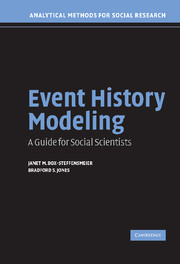Book contents
- Frontmatter
- Contents
- List of Figures
- List of Tables
- Preface
- 1 Event History and Social Science
- 2 The Logic of Event History Analysis
- 3 Parametric Models for Single-Spell Duration Data
- 4 The Cox Proportional Hazards Model
- 5 Models for Discrete Data
- 6 Issues in Model Selection
- 7 Inclusion of Time-Varying Covariates
- 8 Diagnostic Methods for the Event History Model
- 9 Some Modeling Strategies for Unobserved Heterogeneity
- 10 Models for Multiple Events
- 11 The Social Sciences and Event History
- Appendix: Software for Event History Analysis
- References
- Index
5 - Models for Discrete Data
Published online by Cambridge University Press: 05 September 2012
- Frontmatter
- Contents
- List of Figures
- List of Tables
- Preface
- 1 Event History and Social Science
- 2 The Logic of Event History Analysis
- 3 Parametric Models for Single-Spell Duration Data
- 4 The Cox Proportional Hazards Model
- 5 Models for Discrete Data
- 6 Issues in Model Selection
- 7 Inclusion of Time-Varying Covariates
- 8 Diagnostic Methods for the Event History Model
- 9 Some Modeling Strategies for Unobserved Heterogeneity
- 10 Models for Multiple Events
- 11 The Social Sciences and Event History
- Appendix: Software for Event History Analysis
- References
- Index
Summary
The applications of event history methods discussed to this point have all presumed that the event history process is absolutely continuous. This assumes change can occur anywhere in time. Nevertheless, continuity is often belied by the data: measures of time are frequently imprecise, or are made out of practical concerns (and out of convenience). For example, although cabinet governments may fall presumably at any time, the data used in our examples treat the termination point as occurring within a month. This implies that although we have data for processes that are continuous in nature, the data themselves are discrete. As event occurrences amass at discrete intervals, it may be more practical, and perhaps substantively natural, to consider models for discretetime processes. In this chapter, we consider some approaches for modeling event history processes where events only occur (or are only observed) at discrete intervals.
Discrete-Time Data
Event history data for discrete-time processes generally record the dependent variable as a series of binary outcomes denoting whether or not the event of interest occurred at the observation point. To illustrate, consider the public policy data in Table 5.1. These data are from a study of state adoption of restrictive abortion policy (Brace, Hall, and Langer 1999). The event of interest is whether or not a state adopted legislation that placed restrictions on abortion rights. The starting point of the analysis is the first legislative session after the Roe v. Wade decision (1973).
- Type
- Chapter
- Information
- Event History ModelingA Guide for Social Scientists, pp. 69 - 84Publisher: Cambridge University PressPrint publication year: 2004
- 1
- Cited by



